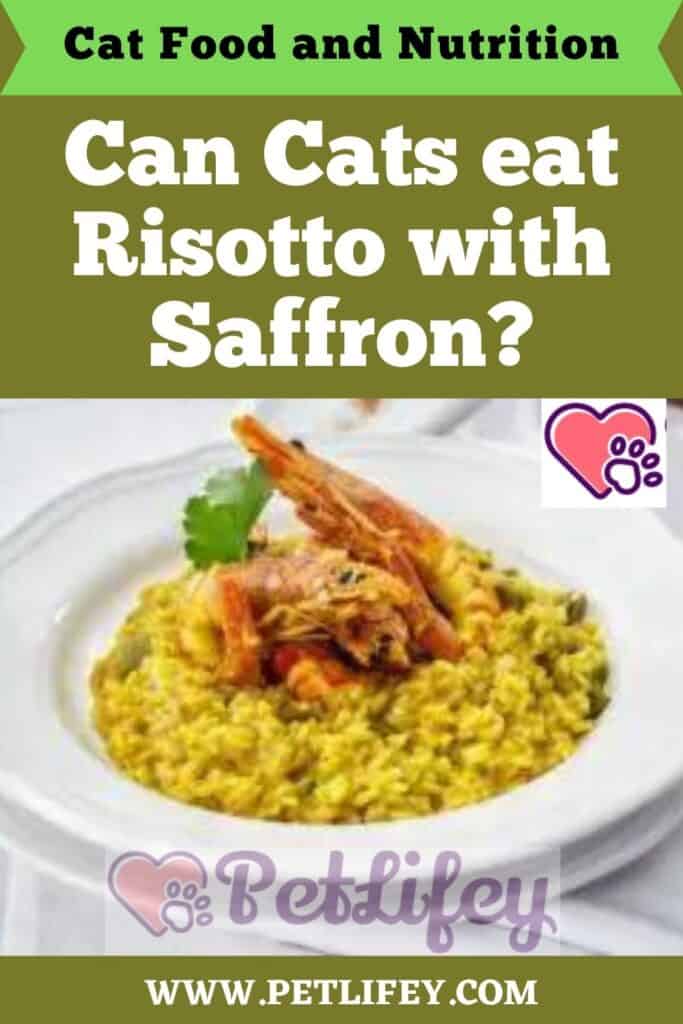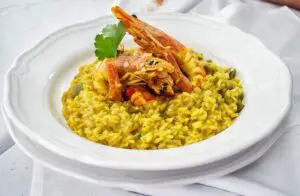
It is understandable that the scent of saffron risotto for home draws the attention of our cat. But can cat eat it?
There are those days when, especially in winter, we like a nice saffron risotto. But only those who own a cat are able to understand that, when he is at home, we could do nothing without being seen by cat. If you then associate the scent emanating from the bubbling of the pot, our cat can’t resist and, with a sweet meow, comes eager to ask us for some. But are we sure that the cat can eat risotto with saffron?
Is it risky to give risotto with saffron to cats?
We know that, even if not excessively, the cat can eat rice. But in this case it is not just plain white rice.
Everyone has their own recipe, sometimes secret, but most of the time various ingredients are used to prepare a saffron risotto. We must evaluate them one by one and, if there was someone who could cause health problems to the cat, we would know that cat will not be able to eat our plate.
A classic saffron risotto recipe includes:
- Rice;
- Burro;
- Onion;
- Saffron;
- Celery, carrot, garlic for the broth;
- Sale;
- Cheese.
We have said that, in small quantities, the cat can eat rice, but without condiments: in our case it is well seasoned, so we still can’t know if it could hurt him by eating it.
In fact, we usually give rice to our cat when he has episodes of diarrhea or gastrointestinal disorders: despite being rich in vitamins and mineral salts such as magnesium (important for muscles, nerves and for the transmission of signals between cells), the rice has a lot of carbohydrates.
The cat is carnivorous and its diet must be based on proteins: too many carbohydrates would cause abdominal bloating, digestive problems and a tendency to gain weight.
Giving your cat some butter also triggers weight gain. However, the fact that it is a food not to be included in its diet is also due to the fact that many cats are lactose intolerant, they do not metabolize it.
Precisely the absence of lactase, or at least its scarce presence, prevents the splitting of lactose into glucose and galactose and makes the butter non-digestible by the cat, with the classic symptoms of intestinal gas accumulation, skin rashes up to vomiting and diarrhea. This also applies to cheese.
Garlic and onion are toxic for cats: they contain large quantities of sulphides and other substances that affect the erythrocytes (red blood cells) of the cat causing a sudden decrease and therefore anemia. If he does eat them, the cat must be taken to the vet immediately.
Celery would only bring benefits to the cat: it has the ability to decrease the concentration of fat and cholesterol in the body and leads to digestion and to fight intestinal swelling. Furthermore, by helping the body to excrete liquids, it collaborates in those mechanisms that cause blood pressure to drop.
Even the carrot, in this case boiled in broth and therefore easily consumed, would allow the cat to assimilate many vitamins and nutrients (such as beta carotene): the problem lies only in the fact that it also contains many sugars, fertile food for gastrointestinal problems and diabetes in cats.
Salt must be completely eliminated in the cat’s diet. Due to its chemical nature, sodium chloride (NaCl) retains water in the tissues, causes a rise in blood pressure and is a contributing cause of renal failure in cats.
And the saffron? Can the cat eat it?
What we eat of saffron are the stigmas, the red threads that come out of the flowers after drying them. It is a very particular plant to handle and the spice that arrives in our dishes has just as many nutritional capacities.
Starting from its particular color, it is easy to deduce that it is rich in carotenoids, but vitamins are not lacking: for example, vitamin A for cats is very important, but also vitamins of group B (thiamin and riboflavin in particular).
Saffron is also rich in antioxidants: they neutralize free radicals and prevent them from attacking cells by denaturing them and intervening in cellular chemical reactions.
Undoubtedly it would be a spice that can also lower stress in cats and improve their mood as well as guaranteeing a general well-being of the organism because it is muscle relaxant and also antiemetic (it fights the senses of vomiting).
However, saffron would be toxic for the cat who ate it: it would be a dangerous food for his health and could cause him:
- Strong inflammation of the mucous membrane of the mouth;
- He retched;
- Diarrhea;
- Damage to vital organs up to and including the bone marrow.
For all these reasons we can say that saffron risotto should not be given to cats.
Useful tips

We cannot think of taking care of our cat in the best possible way by giving in every time it asks us for food that is part of our diet.
His well-being depends on us and we must be aware that some foods are harmful to cats: let’s not feel guilty about saying no to him because we would feel worse if cat then felt bad.
Always ask ourselves if the cat can eat human food before giving it some: its needs are different from ours and its body is not able to metabolize what it ingests as we would.
Now that we know that we could risk anemia for the cat, it is good to remember, for example, that garlic and onion absolutely must not exist in its diet, even if we just wanted to make it taste something that contains them.
The best thing we can do for our cat is to provide a balanced diet, knowing that for the most part it must be based on a protein requirement: it is a carnivore and, for example, too many carbohydrates would only harm and cause obesity in the cat.
We always keep under control possible intolerances, such as lactose intolerance for cat, and whenever we need to dispel a doubt we consult the veterinarian, only the veterinarian.






